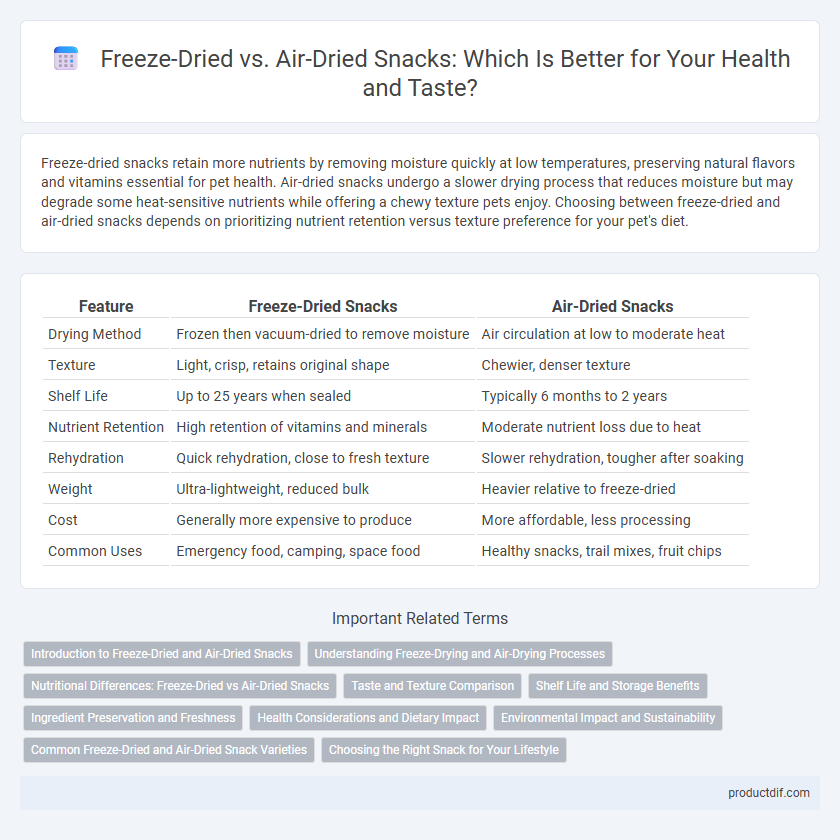Freeze-dried snacks retain more nutrients by removing moisture quickly at low temperatures, preserving natural flavors and vitamins essential for pet health. Air-dried snacks undergo a slower drying process that reduces moisture but may degrade some heat-sensitive nutrients while offering a chewy texture pets enjoy. Choosing between freeze-dried and air-dried snacks depends on prioritizing nutrient retention versus texture preference for your pet's diet.
Table of Comparison
| Feature | Freeze-Dried Snacks | Air-Dried Snacks |
|---|---|---|
| Drying Method | Frozen then vacuum-dried to remove moisture | Air circulation at low to moderate heat |
| Texture | Light, crisp, retains original shape | Chewier, denser texture |
| Shelf Life | Up to 25 years when sealed | Typically 6 months to 2 years |
| Nutrient Retention | High retention of vitamins and minerals | Moderate nutrient loss due to heat |
| Rehydration | Quick rehydration, close to fresh texture | Slower rehydration, tougher after soaking |
| Weight | Ultra-lightweight, reduced bulk | Heavier relative to freeze-dried |
| Cost | Generally more expensive to produce | More affordable, less processing |
| Common Uses | Emergency food, camping, space food | Healthy snacks, trail mixes, fruit chips |
Introduction to Freeze-Dried and Air-Dried Snacks
Freeze-dried snacks retain over 97% of their original nutrients by removing moisture through sublimation, making them lightweight and shelf-stable without preservatives. Air-dried snacks are created by slowly evaporating moisture at low temperatures, preserving flavor and texture while maintaining a chewy consistency. Both methods extend shelf life and reduce weight but differ significantly in texture, nutrient retention, and processing time.
Understanding Freeze-Drying and Air-Drying Processes
Freeze-drying removes moisture by freezing the food and then applying a vacuum to sublimate ice directly into vapor, preserving cellular structure and nutrients. Air-drying dehydrates food through circulation of warm air, causing gradual water evaporation that may alter texture and nutrient retention. Freeze-dried snacks often maintain superior flavor, texture, and nutritional content compared to the denser and chewier air-dried alternatives.
Nutritional Differences: Freeze-Dried vs Air-Dried Snacks
Freeze-dried snacks retain up to 97% of their original nutrients, including vitamins and antioxidants, due to the low-temperature dehydration process that minimizes nutrient degradation. Air-dried snacks, exposed to higher heat, often lose more water-soluble vitamins like vitamin C and certain B vitamins, resulting in lower overall nutrient retention. The preservation method influences fiber content and antioxidant levels, with freeze-drying generally maintaining superior nutritional profiles compared to air-drying.
Taste and Texture Comparison
Freeze-dried snacks retain more of the original flavor intensity and offer a light, crisp texture due to the sublimation process removing moisture without heat. Air-dried snacks provide a chewier and denser texture, with a slightly muted taste as heat can alter the flavor profile during dehydration. Both methods preserve nutrients, but freeze-drying is preferred for maintaining peak taste and an airy crunch.
Shelf Life and Storage Benefits
Freeze-dried snacks offer an extended shelf life of up to 25 years due to their low moisture content, making them ideal for long-term storage and emergency preparedness. Air-dried snacks typically last between 6 months to 1 year, with higher moisture levels that require cool, dry storage to prevent spoilage. Freeze-drying preserves more nutrients and texture, while air-drying is cost-effective but less efficient in prolonging shelf life.
Ingredient Preservation and Freshness
Freeze-dried snacks retain up to 97% of their original nutrients and maintain the natural flavor and color of ingredients due to rapid moisture removal under low temperatures. Air-dried snacks experience longer drying times at higher temperatures, often leading to nutrient degradation and a less vibrant taste profile. The superior ingredient preservation in freeze-dried snacks enhances freshness and shelf life compared to air-dried alternatives.
Health Considerations and Dietary Impact
Freeze-dried snacks retain more nutrients, such as vitamins and antioxidants, due to the low-temperature dehydration process that preserves their original food structure. Air-dried snacks often have higher moisture loss but can result in nutrient degradation and potential loss of heat-sensitive vitamins. Both options offer low-calorie alternatives to traditional snacks, but freeze-dried varieties generally provide superior nutrient density, making them a healthier choice for nutrient-conscious diets.
Environmental Impact and Sustainability
Freeze-dried snacks consume significantly more energy due to the intensive freezing and vacuum processes involved, whereas air-dried snacks use less energy by relying on natural airflow and lower temperatures. The carbon footprint of freeze-dried products tends to be higher, contributing more to greenhouse gas emissions compared to the more sustainable air-drying method. Air-dried snacks also minimize water usage and preserve nutrients effectively, making them a greener choice for environmentally conscious consumers.
Common Freeze-Dried and Air-Dried Snack Varieties
Common freeze-dried snack varieties include fruits like strawberries, apples, and blueberries, as well as vegetables such as peas and corn, prized for their lightweight texture and retained nutrients. Air-dried snacks often feature fruits like mango slices, banana chips, and apple rings, along with jerky made from beef or turkey, known for their chewy texture and natural flavors. Both drying methods offer shelf-stable, nutrient-dense options, with freeze-drying preserving more vitamins and air-drying enhancing texture and taste.
Choosing the Right Snack for Your Lifestyle
Freeze-dried snacks retain more nutrients and have a crispier texture compared to air-dried snacks, making them ideal for those seeking maximum flavor and health benefits. Air-dried snacks offer a softer texture and often lower production costs, suitable for casual snacking and budget-conscious consumers. Selecting between freeze-dried and air-dried snacks depends on your lifestyle priorities, such as nutrient retention, taste preference, and convenience.
Freeze-Dried Snacks vs Air-Dried Snacks Infographic

 productdif.com
productdif.com